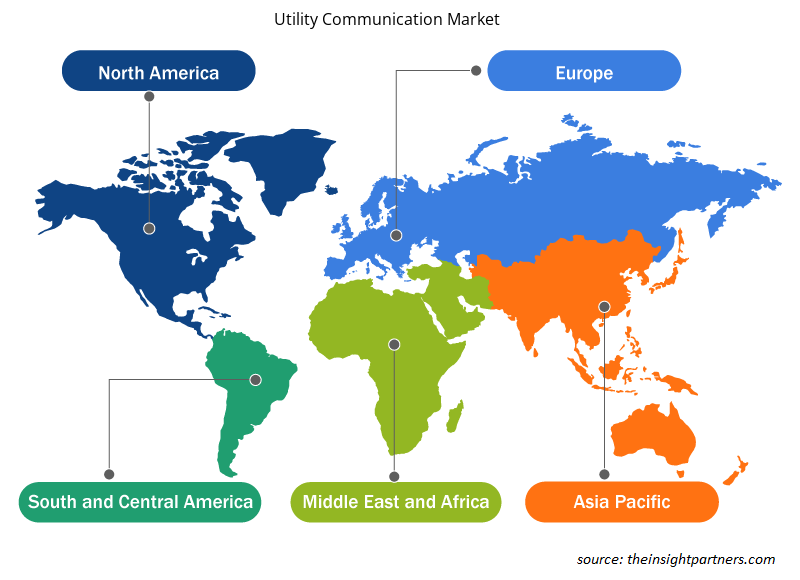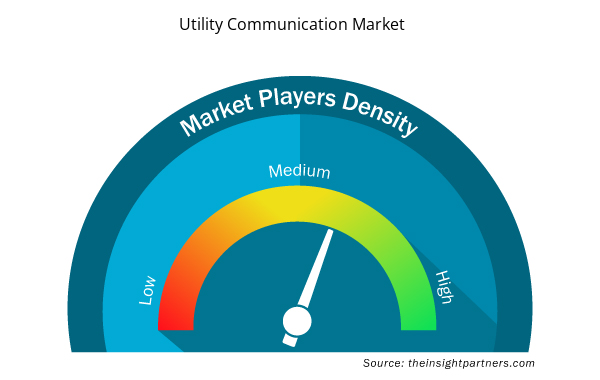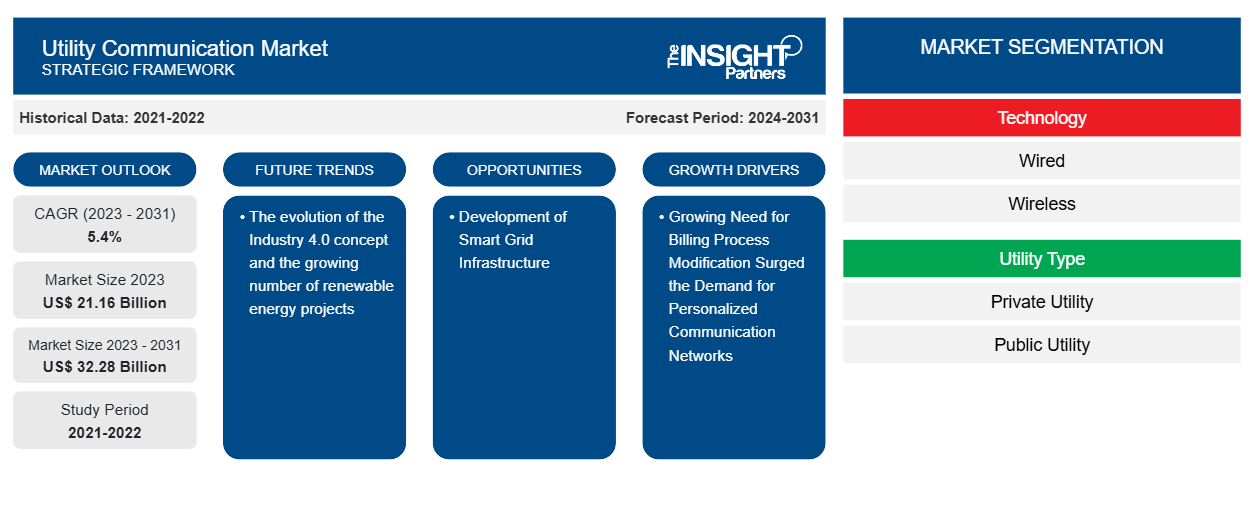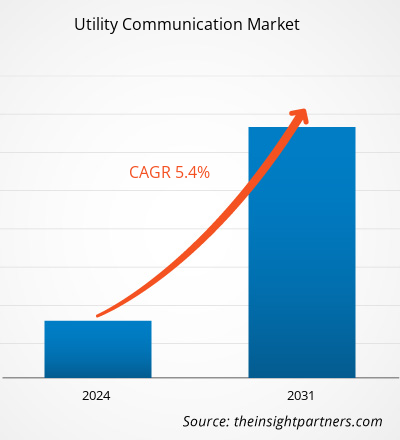ユーティリティ通信市場の規模は、2023 年の 211.6 億米ドルから 2031 年には 322.8 億米ドルに達すると予測されています。市場は 2023 年から 2031 年にかけて 5.4% の CAGR を記録すると予想されています。インダストリー 4.0 コンセプトの進化と再生可能エネルギー プロジェクトの増加は、ユーティリティ通信市場の重要なトレンドであり続けると思われます。
ユーティリティ通信市場分析
公共通信市場は、課金プロセスの変更の必要性が高まり、パーソナライズされた通信ネットワークの需要が急増し、分散型エネルギーリソース (DER) の需要も高まっているため、急速に成長しています。市場は、電力インフラの開発を促進するための政府の好ましい取り組みと投資に牽引され、着実に拡大しています。さらに、スマートグリッド インフラの開発と、モノのインターネット (IoT) と人工知能 (AI) を統合した技術的に高度なシステムの採用の増加により、市場の成長に有利な機会が生まれています。
ユーティリティ通信市場の概要
ユーティリティ通信は、WAN および LAN を介したデータ、ビデオ、音声のより信頼性が高く、安全で、安全な伝送を保証するシステムです。この通信システムは、危険な場所に簡単に設置できるという利点をユーザーに提供します。ユーティリティ通信システムは、ビデオ監視、スマート グリッド、監視制御およびデータ収集 (SADA) システム、イーサネット ベースの接続など、多数のネットワークを使用して機能します。さらに、電力消費と配電を監視するためのユーティリティによる有線および無線通信システムの需要の高まりにより、予測期間中に市場が拡大しています。
要件に合わせてレポートをカスタマイズする
このレポートの一部、国レベルの分析、Excelデータパックなど、あらゆるレポートを無料でカスタマイズできます。また、スタートアップや大学向けのお得なオファーや割引もご利用いただけます。
- このレポートの主要な市場動向を入手してください。この無料サンプルには、市場動向から見積もりや予測に至るまでのデータ分析が含まれます。
ユーティリティ通信市場の地域別洞察
予測期間を通じてユーティリティ通信市場に影響を与える地域的な傾向と要因は、Insight Partners のアナリストによって徹底的に説明されています。このセクションでは、北米、ヨーロッパ、アジア太平洋、中東およびアフリカ、南米および中米にわたるユーティリティ通信市場のセグメントと地理についても説明します。

- ユーティリティ通信市場の地域別データを入手
ユーティリティ通信市場レポートの範囲
| レポート属性 | 詳細 |
|---|---|
| 2023年の市場規模 | 211.6億米ドル |
| 2031年までの市場規模 | 322.8億米ドル |
| 世界のCAGR(2023年~2031年) | 5.4% |
| 履歴データ | 2021-2022 |
| 予測期間 | 2024-2031 |
| 対象セグメント | テクノロジー別
|
| 対象地域と国 | 北米
|
| 市場リーダーと主要企業プロフィール |
|
市場プレーヤーの密度:ビジネスダイナミクスへの影響を理解する
ユーティリティ通信市場は、消費者の嗜好の変化、技術の進歩、製品の利点に対する認識の高まりなどの要因により、エンドユーザーの需要が高まり、急速に成長しています。需要が高まるにつれて、企業は提供内容を拡大し、消費者のニーズを満たすために革新し、新たなトレンドを活用し、市場の成長をさらに促進しています。
市場プレーヤー密度とは、特定の市場または業界内で活動している企業または会社の分布を指します。これは、特定の市場スペースに、その規模または総市場価値と比較して、どれだけの競合相手 (市場プレーヤー) が存在するかを示します。
ユーティリティ通信市場で事業を展開している主要企業は次のとおりです。
- ABB株式会社
- 富士通株式会社
- ゼネラル・エレクトリック・カンパニー
- ハネウェルインターナショナル
- オミクロンエレクトロニクス株式会社
- ロックウェル・オートメーション
免責事項:上記の企業は、特定の順序でランク付けされていません。

- ユーティリティ通信市場のトップキープレーヤーの概要を入手
- 過去2年間の分析、基準年、CAGRによる予測(7年間)
- PEST分析とSWOT分析
- 市場規模価値/数量 - 世界、地域、国
- 業界と競争環境
- Excel データセット


- Aircraft Landing Gear Market
- Water Pipeline Leak Detection System Market
- Nuclear Waste Management System Market
- Aerospace Forging Market
- Mobile Phone Insurance Market
- Battery Testing Equipment Market
- Dealer Management System Market
- Genetic Testing Services Market
- Rugged Servers Market
- Precast Concrete Market

Report Coverage
Revenue forecast, Company Analysis, Industry landscape, Growth factors, and Trends

Segment Covered
This text is related
to segments covered.

Regional Scope
North America, Europe, Asia Pacific, Middle East & Africa, South & Central America

Country Scope
This text is related
to country scope.
よくある質問
The incremental growth expected to be recorded for the global utility communication market during the forecast period is US$ 11.12 billion.
The global utility communication market is expected to reach US$ 32.28 billion by 2031.
The key players holding majority shares in the global utility communication market are ABB Ltd, Fujitsu Limited, General Electric Company, Honeywell International Inc, and Omicron Electronics GmbH.
The evolution of the Industry 4.0 concept and the growing number of renewable energy projects to play a significant role in the global utility communication market in the coming years.
The growing need for billing process modification surged the demand for personalized communication networks and the increasing demand for distributed energy resources (DER) are the major factors that propel the global utility communication market.
The global utility communication market was estimated to be US$ 21.16 billion in 2023 and is expected to grow at a CAGR of 5.4% during the forecast period 2023 - 2031.
Trends and growth analysis reports related to Electronics and Semiconductor : READ MORE..
The Insight Partners performs research in 4 major stages: Data Collection & Secondary Research, Primary Research, Data Analysis and Data Triangulation & Final Review.
- Data Collection and Secondary Research:
As a market research and consulting firm operating from a decade, we have published and advised several client across the globe. First step for any study will start with an assessment of currently available data and insights from existing reports. Further, historical and current market information is collected from Investor Presentations, Annual Reports, SEC Filings, etc., and other information related to company’s performance and market positioning are gathered from Paid Databases (Factiva, Hoovers, and Reuters) and various other publications available in public domain.
Several associations trade associates, technical forums, institutes, societies and organization are accessed to gain technical as well as market related insights through their publications such as research papers, blogs and press releases related to the studies are referred to get cues about the market. Further, white papers, journals, magazines, and other news articles published in last 3 years are scrutinized and analyzed to understand the current market trends.
- Primary Research:
The primarily interview analysis comprise of data obtained from industry participants interview and answers to survey questions gathered by in-house primary team.
For primary research, interviews are conducted with industry experts/CEOs/Marketing Managers/VPs/Subject Matter Experts from both demand and supply side to get a 360-degree view of the market. The primary team conducts several interviews based on the complexity of the markets to understand the various market trends and dynamics which makes research more credible and precise.
A typical research interview fulfils the following functions:
- Provides first-hand information on the market size, market trends, growth trends, competitive landscape, and outlook
- Validates and strengthens in-house secondary research findings
- Develops the analysis team’s expertise and market understanding
Primary research involves email interactions and telephone interviews for each market, category, segment, and sub-segment across geographies. The participants who typically take part in such a process include, but are not limited to:
- Industry participants: VPs, business development managers, market intelligence managers and national sales managers
- Outside experts: Valuation experts, research analysts and key opinion leaders specializing in the electronics and semiconductor industry.
Below is the breakup of our primary respondents by company, designation, and region:

Once we receive the confirmation from primary research sources or primary respondents, we finalize the base year market estimation and forecast the data as per the macroeconomic and microeconomic factors assessed during data collection.
- Data Analysis:
Once data is validated through both secondary as well as primary respondents, we finalize the market estimations by hypothesis formulation and factor analysis at regional and country level.
- Macro-Economic Factor Analysis:
We analyse macroeconomic indicators such the gross domestic product (GDP), increase in the demand for goods and services across industries, technological advancement, regional economic growth, governmental policies, the influence of COVID-19, PEST analysis, and other aspects. This analysis aids in setting benchmarks for various nations/regions and approximating market splits. Additionally, the general trend of the aforementioned components aid in determining the market's development possibilities.
- Country Level Data:
Various factors that are especially aligned to the country are taken into account to determine the market size for a certain area and country, including the presence of vendors, such as headquarters and offices, the country's GDP, demand patterns, and industry growth. To comprehend the market dynamics for the nation, a number of growth variables, inhibitors, application areas, and current market trends are researched. The aforementioned elements aid in determining the country's overall market's growth potential.
- Company Profile:
The “Table of Contents” is formulated by listing and analyzing more than 25 - 30 companies operating in the market ecosystem across geographies. However, we profile only 10 companies as a standard practice in our syndicate reports. These 10 companies comprise leading, emerging, and regional players. Nonetheless, our analysis is not restricted to the 10 listed companies, we also analyze other companies present in the market to develop a holistic view and understand the prevailing trends. The “Company Profiles” section in the report covers key facts, business description, products & services, financial information, SWOT analysis, and key developments. The financial information presented is extracted from the annual reports and official documents of the publicly listed companies. Upon collecting the information for the sections of respective companies, we verify them via various primary sources and then compile the data in respective company profiles. The company level information helps us in deriving the base number as well as in forecasting the market size.
- Developing Base Number:
Aggregation of sales statistics (2020-2022) and macro-economic factor, and other secondary and primary research insights are utilized to arrive at base number and related market shares for 2022. The data gaps are identified in this step and relevant market data is analyzed, collected from paid primary interviews or databases. On finalizing the base year market size, forecasts are developed on the basis of macro-economic, industry and market growth factors and company level analysis.
- Data Triangulation and Final Review:
The market findings and base year market size calculations are validated from supply as well as demand side. Demand side validations are based on macro-economic factor analysis and benchmarks for respective regions and countries. In case of supply side validations, revenues of major companies are estimated (in case not available) based on industry benchmark, approximate number of employees, product portfolio, and primary interviews revenues are gathered. Further revenue from target product/service segment is assessed to avoid overshooting of market statistics. In case of heavy deviations between supply and demand side values, all thes steps are repeated to achieve synchronization.
We follow an iterative model, wherein we share our research findings with Subject Matter Experts (SME’s) and Key Opinion Leaders (KOLs) until consensus view of the market is not formulated – this model negates any drastic deviation in the opinions of experts. Only validated and universally acceptable research findings are quoted in our reports.
We have important check points that we use to validate our research findings – which we call – data triangulation, where we validate the information, we generate from secondary sources with primary interviews and then we re-validate with our internal data bases and Subject matter experts. This comprehensive model enables us to deliver high quality, reliable data in shortest possible time.


 このレポートの無料サンプルを入手する
このレポートの無料サンプルを入手する